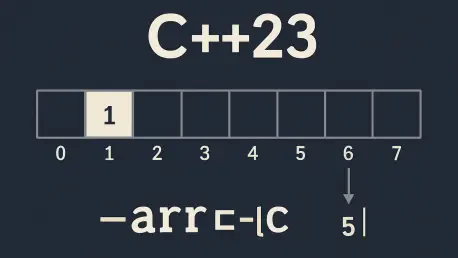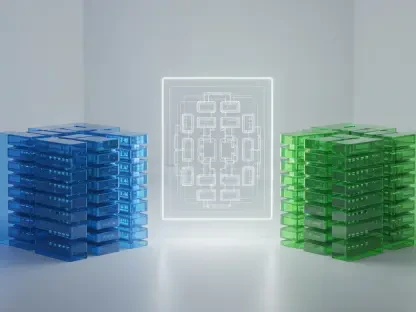In the ever-evolving landscape of programming languages, C++23 emerges as a beacon of innovation, particularly for developers grappling with the complexities of multidimensional arrays in fields like machine learning, scientific computing, and game development. Picture a scenario where a software engineer is deep into a project involving intricate data structures such as matrices or tensors, only to be bogged down by cumbersome syntax that obscures the logic of the code. Traditional methods of accessing elements in these arrays often involve nested brackets, leading to visual clutter and potential errors. Enter the multidimensional subscript operator, a standout feature of C++23, designed to revolutionize how programmers interact with such data. This update promises not only to enhance readability but also to streamline workflows, making code more intuitive and less prone to mistakes. By addressing a long-standing pain point, C++23 positions itself as a vital tool for modern developers aiming to tackle complex challenges with elegance and efficiency.
Unpacking the Importance of Multidimensional Arrays
Multidimensional arrays serve as fundamental building blocks in numerous high-tech domains, enabling the representation of complex data in forms like 2D grids for image processing or higher-dimensional tensors for neural network models. These structures are indispensable when handling vast datasets that require organization across multiple axes, yet the traditional syntax for accessing their elements has often been a source of frustration. Developers have long dealt with nested subscript operators, such as array[1][2], which become increasingly unwieldy as dimensions grow. This complexity not only hampers readability but also heightens the risk of indexing errors during development. C++23 steps into this arena with a solution that prioritizes clarity, aiming to reduce the cognitive load on programmers. By refining how these arrays are accessed, the standard seeks to empower professionals to focus on solving core problems rather than deciphering convoluted code structures, marking a significant shift in programming ease.
The significance of multidimensional arrays extends beyond mere data storage, as they underpin critical computations in cutting-edge fields. Consider scientific simulations where 3D arrays model physical phenomena, or computer vision applications where pixel data is organized into matrices—each relies heavily on efficient array manipulation. Historically, the syntax for navigating these structures has deterred rapid prototyping and debugging, often leading to maintenance challenges in large-scale projects. The innovation introduced by C++23 addresses these hurdles head-on by rethinking access methods, ensuring that code reflects the logical structure of the data more naturally. This advancement is not just a technical tweak but a response to real-world needs, catering to industries where precision and speed are paramount. As developers adopt this feature, the ripple effect on productivity and code quality could redefine standards in software development across diverse sectors.
Diving into the Multidimensional Subscript Operator
At the heart of C++23’s enhancements lies the multidimensional subscript operator, a feature that transforms how developers interact with arrays by introducing a cleaner, more intuitive syntax. Instead of wrestling with nested brackets for each dimension, programmers can now use a single set of square brackets with comma-separated indices, such as matrix[1, 2], to access elements directly. This shift might seem subtle at first glance, but its impact on code readability is profound, especially when dealing with higher-dimensional data like 3D or 4D arrays. The reduction in visual noise allows for quicker comprehension of code logic, which is invaluable during both writing and reviewing phases. Furthermore, this syntax minimizes the likelihood of typos or logical errors in indexing, a common pitfall in traditional approaches. By prioritizing simplicity, C++23 equips developers with a tool that enhances precision in handling complex data structures.
Beyond its aesthetic appeal, the multidimensional subscript operator offers practical advantages that resonate with modern programming demands. Its design aligns C++ more closely with syntax conventions seen in other languages like Python and MATLAB, where comma-separated indices are already standard for multidimensional access. This harmonization facilitates smoother transitions for developers working across multiple platforms, reducing the learning curve and fostering collaboration in interdisciplinary projects. Additionally, the operator supports a more expressive coding style, allowing algorithms to be articulated in a way that mirrors mathematical notation often used in theoretical models. For teams tackling data-intensive tasks, this means faster iterations and fewer misunderstandings when sharing code. The streamlined syntax not only saves time but also elevates the overall clarity of implementations, making it a pivotal update for anyone invested in leveraging C++ for advanced computations.
Compatibility with Existing C++ Frameworks
One of the most compelling aspects of the multidimensional subscript operator in C++23 is its seamless integration with the broader C++ ecosystem, ensuring that developers can adopt this feature without overhauling existing codebases. Whether working with traditional C-style arrays, the more modern std::array containers, or even bespoke data structures, this operator adapts effortlessly. Through the power of operator overloading, it becomes possible to customize its behavior for user-defined types, offering unparalleled flexibility in tailoring solutions to specific project needs. This compatibility means that legacy systems and new developments can coexist, allowing gradual adoption rather than forced migration. For organizations maintaining extensive code libraries, this aspect of C++23 provides reassurance that innovation does not come at the cost of disruption, preserving investments in established frameworks while embracing cutting-edge tools.
Equally important is how this feature enhances day-to-day coding practices, particularly in iterative processes like loop construction for array traversal. The simplified syntax reduces the mental overhead associated with managing multiple nested brackets, thereby lowering the incidence of off-by-one errors or incorrect dimension referencing. Developers crafting algorithms for data processing can thus devote more attention to optimizing logic rather than debugging syntax-related bugs. This improvement is especially beneficial in collaborative environments where code must be understood and modified by multiple team members over time. By embedding this operator into routine operations, C++23 ensures that efficiency gains are not just theoretical but felt in tangible ways during development cycles. The result is a more robust coding experience that aligns with the practical realities of maintaining and scaling software solutions across various applications.
Transforming Real-World Applications
The introduction of the multidimensional subscript operator in C++23 carries profound implications for industries reliant on multidimensional data, where streamlined access can significantly boost operational efficiency. In fields like machine learning, where tensors form the backbone of neural network architectures, this feature simplifies the manipulation of high-dimensional datasets, enabling researchers to craft algorithms with greater speed and accuracy. Similarly, in scientific computing, simulations involving multidimensional grids benefit from clearer code that mirrors the conceptual models being tested. This clarity translates into faster prototyping and more reliable results, critical for advancing research and development. By reducing the friction associated with data access, C++23 empowers professionals to push boundaries in innovation, ensuring that technical barriers do not impede progress in solving complex, real-world problems.
Moreover, the impact of this feature extends to commercial software development, where multidimensional arrays are often integral to graphics engines and data analytics platforms. Game developers, for instance, can manage spatial data more effectively, crafting immersive environments without getting bogged down by intricate syntax. In data analytics, where large matrices underpin statistical computations, the enhanced readability fosters better collaboration among teams analyzing trends and patterns. This operator also supports rapid iteration, a crucial factor in competitive markets where time-to-market can determine success. As industries increasingly rely on data-driven decision-making, the ability to handle multidimensional structures with ease becomes a strategic advantage. C++23, through this update, positions itself as a key enabler for applications that demand both performance and accessibility, bridging the gap between theoretical potential and practical deployment.
Fostering a Collaborative Coding Environment
The multidimensional subscript operator also reflects a broader movement in programming language design toward greater intuitiveness, a trend that C++23 champions with this feature. By adopting a syntax that resonates with conventions in other widely-used languages, it lowers barriers for developers transitioning between different tools and ecosystems. This alignment is particularly valuable in multidisciplinary projects where team members might bring expertise from varied programming backgrounds, ensuring that codebases remain approachable regardless of one’s primary language. Such interoperability can accelerate project timelines by minimizing miscommunication and fostering a shared understanding of data access patterns. In an era where collaboration often spans global teams, this aspect of C++23 serves as a unifying force, enhancing the collective ability to tackle intricate challenges with cohesive strategies.
Additionally, the emphasis on simplicity in this feature contributes to long-term code maintainability, a critical concern in software engineering. Code that is easier to read and interpret naturally lends itself to smoother updates and debugging, especially in large-scale systems where multiple developers contribute over extended periods. The reduced complexity of array access syntax means that onboarding new team members becomes less daunting, as they can quickly grasp the structure of existing implementations. This fosters an environment where knowledge transfer happens organically, strengthening team dynamics and project continuity. As programming communities continue to prioritize user-friendly design, the multidimensional subscript operator stands as a testament to C++23’s commitment to not just technical excellence but also to nurturing a more connected and efficient developer ecosystem, ready to adapt to future demands.
Reflecting on a Progressive Leap Forward
Looking back, the rollout of the multidimensional subscript operator in C++23 marked a pivotal moment in the evolution of C++, addressing critical challenges in managing multidimensional arrays with finesse. Its introduction brought a wave of clarity to codebases that were once mired in nested bracket confusion, offering developers a streamlined path to handle intricate data structures. The seamless fit with existing tools and its resonance with syntax from other languages underscored a thoughtful approach to modernization. For those who adopted it, the benefits in readability and error reduction were immediate, reshaping workflows across diverse industries. Moving forward, the focus should be on exploring how this feature can be leveraged further, perhaps through educational initiatives to spread best practices or through integration into emerging tools for data analysis. As C++ continues to adapt, such advancements pave the way for even more intuitive solutions, ensuring that developers are equipped to meet the complexities of tomorrow’s technological landscape with confidence.









